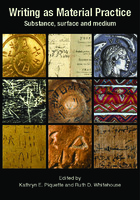Writing as Material Practice
Substance, surface and medium
Author(s)
Whitehouse, Ruth D.
Contributor(s)
Piquette, Kathryn E. (editor)
Language
EnglishAbstract
Writing as Material Practice grapples with the issue of writing as a form of material culture in its ancient and more recent manifestations, and in the contexts of production and consumption. Fifteen case studies explore the artefactual nature of writing — the ways in which materials, techniques, colour, scale, orientation and visibility inform the creation of inscribed objects and spaces, as well as structure subsequent engagement, perception and meaning making. Covering a temporal span of some 5000 years, from c.3200 BCE to the present day, and ranging in spatial context from the Americas to the Near East, the chapters in this volume bring a variety of perspectives which contribute to both specific and broader questions of writing materialities.
The authors also aim to place past graphical systems in their social contexts so they can be understood in relation to the people who created and attributed meaning to writing and associated symbolic modes through a diverse array of individual and wider social practices.
(DOI: http://dx.doi.org/10.5334/bai)
Keywords
material culture; artefact; archaeology; symbolism; writing; Clay tablet; Quipu; SitulaDOI
10.5334/baiISBN
9781909188259;9781909188266Publisher
Ubiquity PressPublisher website
https://www.ubiquitypress.com/Publication date and place
2013Classification
Archaeology
Social and cultural anthropology


 Download
Download Web Shop
Web Shop